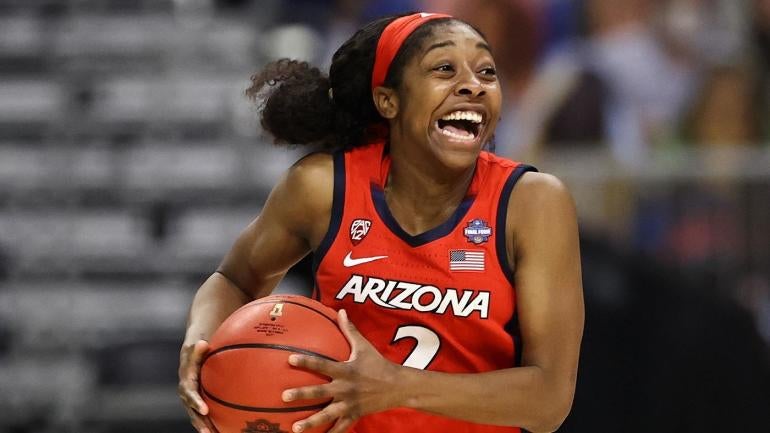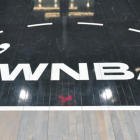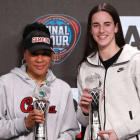
Earlier this month, the 2021 NCAA Women's Tournament concluded in thrilling fashion, as Aari McDonald's heave at the buzzer clanked off the rim, giving the Stanford Cardinal a one-point win and their first title since 1992. But while the Arizona Wildcats ultimately fell short, McDonald stole the show. Her tremendous play in March and early April made her a national star, and dramatically improved her draft stock.
With the 2021 WNBA Draft now just days away, let's take a closer look at the point guard's strengths and weaknesses.
Strengths
Defense
As we saw in the NCAA Women's Tournament, and over the course of her collegiate career, McDonald is just a tremendous defensive player. It takes something really special to win back-to-back Pac-12 Defensive Player of the Year Awards as a 5-foot-6 guard, and McDonald has it.
The first thing that jumps out is McDonald's steals numbers, which ranked No. 32 in the nation at 2.6 per game. Whether she was smothering ball handlers with her quick feet and hands, or jumping out into passing lanes, McDonald was always a threat to take the ball and jet off the other way for an easy two points.
But, of course, defense isn't just about steals, and McDonald's ability on that end manifests in so many different ways. Here are just a few examples.
Against UConn in the Final Four, she was a big factor in limiting Wooden Award winner Paige Bueckers to just a 5-for-13 shooting performance. Watch how she shadows her across the court, denying her the ball and forcing UConn to readjust, which eventually leads to a turnover.
Earlier in the season against UCLA, we saw her ability to move her feet and take away driving lanes. After picking Charisma Osborne up near the top of the key, she maneuvers around the screen, gets to the spot early and draws the charge.
And when Arizona was playing at Oregon, her relentless full-court pressure made the Ducks' All-Pac-12 point guard Te-Hina Paopao simply stop trying to bring up the ball. Look at Paopao just point to another Oregon guard and make her way up the floor. Even the announcers remark on the fact that McDonald changed how teams have to play.
If all that wasn't enough, McDonald is also a strong rebounder for a point guard. Her 5.4 rebounds per game were second on the team, and she's able to help finish off possessions by crashing the glass.
Playmaking
During the Wildcats' run to the championship game, McDonald took on a much larger scoring role, which to some extent obscured her playmaking abilities. But as she showed all season, and throughout her time in college, she's quite a talented passer.
Her four assists per game ranked in the 96th percentile in the country, per Her Hoops Stats, and the fact that she was able to get even that many given the lack of offensive talent around her is a real testament to the way she sets up teammates. Arizona only had one other double-digit scorer this season -- Cate Reese at 10.9 points per game -- and as a team shot just 40.9 percent from the field.
McDonald did rack up a fair amount of turnovers, but that was more a product of her having the ball all the time. Only six players in the country had more offensive possessions, and her actual turnover rate of 13.4 percent was really not that bad.
Most notably, she's a smooth operator in the pick-and-roll, where her passes generated 1.128 points per possession, per Synergy Sports. Some of her reads and passes out of PNRs are really advanced, and will translate even better in the WNBA when she has more talent around her.
Getting out in transition
McDonald's speed and quickness aren't just an advantage in the halfcourt. She loves to get out and run in transition, where she's arguably at her best on the offensive side of the ball. Certainly, it's where she's most efficient. Her 151 transition possessions were the 20th most for any player in Division I, and she scored 1.053 points per possession on those opportunities.
We've already seen how she can use her defense to create easy offense on the break, but that wasn't McDonald's only approach. She was always looking for opportunities to get out and run, whether it was leaking out after a rebound, or using her pure speed to catch the defense napping.
Examples of the latter were perhaps the most impressive. Late in the game against Arizona State, McDonald got the ball near the baseline and raced the length of the court for a layup, despite the fact that every player on the Sun Devils had at least a 10-20 foot head start on her.
Weaknesses
Size
Just like Louisville's Dana Evans, another of the top point guards in this draft class, McDonald stands just 5-foot-6, which will make her one of the smallest players in the league. In fact, only Crystal Dangerfield and Leilani Mitchell are shorter. That doesn't mean McDonald can't succeed -- Dangerfield just won Rookie of the Year last season at 5-foot-5 -- but it does mean that everything will be a little more difficult.
That will especially be the case if McDonald doesn't improve her outside shooting. If teams don't have to respect her shot and can sit back to prevent the drive, that will negate some of her ability to get into the lane and create.
And on the defensive end, she'll almost always be guarding a bigger player. That's not a major concern considering she was the back-to-back Pac-12 Defensive Player of the Year doing the same thing in college, but at the WNBA level opponents are going to not only be bigger and stronger, but better shotmakers.
3-point shooting
If you only watched the NCAA Women's Tournament, you would think that McDonald is one of the best shooters in this draft class. She was unconscious in the last four rounds of the tourney, going 19-of-36, and making at least four 3s in each game.
But while her hot streak was incredible and a big reason she led the Wildcats to their first national championship game, it was also an outlier. Prior to that run she only had seven games with four or more made 3s in her three full seasons at Arizona. And during those regular seasons, she shot 28.1 percent from downtown as a sophomore, 27.8 percent as a junior and 29.6 percent as a senior.
In short, her 3-point shot is a huge question mark. Based on where she's starting from, it's hard to imagine she'll ever become an elite shooter from outside. The good news is she doesn't have to be. She's so quick and shifty with the ball that if she can just make them regularly enough to hold defenses accountable, that will go a long way. Whether she can reach that point, however, remains to be seen.
Finishing in the paint
As you've seen, McDonald doesn't shoot the ball well from outside, and she's not all that efficient inside the arc either. While she put up over 20 points per game in all three seasons with the Wildcats, she was definitely a volume scorer -- though to be fair, that's what her team needed from her.
One issue, which relates back to her size, is that McDonald doesn't finish all that well in the paint or around the rim when she's under pressure from defenders. For the season she made 61.6 percent of her attempts at the basket, and 42.3 percent of her attempts in the paint overall.
Just for comparison, here's how that stacks up against some recent small guard prospects in their final season in college:
| Player | Season | Efficiency at the rim | Efficiency in the paint |
|---|---|---|---|
Dana Evans | 2020-21 | 63.5% | 45.0% |
Crystal Dangerfield | 2019-20 | 68.8% | 54.9% |
Chennedy Carter | 2019-20 | 77.6% | 51.3% |
Arike Ogunbowale | 2018-19 | 67.1% | 39.8% |
There were just too many times where she'd make a great initial move to get into the lane, only to get swallowed up by the opposing bigs, have to readjust, or just miss. It's not going to get easier in the pros.
Conclusion
McDonald didn't win Most Outstanding Player because Arizona lost in the title game, but she was the best player in the NCAA Women's Tournament. In the process, she likely established herself as a top-five pick and if so will be the first point guard off the board.
Now, she was already a certified top-10 pick before the season even started, so it's not like she made some ridiculous jump. At the same time, there's always a worry about reading too much into a tournament run, and McDonald has some real flaws. If she's not going to be able to make 3s or finish around the basket at a high rate, it will make it much easier for teams to defend her. Then there's also the size.
At the same time, we know McDonald is going to do some things very well, namely defend and make plays for others. Those traits will give her a chance to stay on the floor and work on her weaknesses. There's also something of an "it factor" with McDonald, which we saw time and again in the tournament. It's hard to quantify without being around her or her team every day, but there's clearly more to McDonald's impact than the stats would tell you.
All of which makes McDonald a difficult player to project. There are valid reasons to have concerns about her ability to make an impact at the next level, valid reasons to think she'll do very well in the WNBA and plenty of outcomes in between. In the end, as is the case for so many players, the difference-maker will probably be her shooting and how much that improves.






















